2014 年陕西空军工程大学综合英语考研真题(A 卷)
考试科目:综合英语(A 卷) 科目代码 882
说明:答题时必须答在配发的空白答题纸上,答题可不抄题,但必须写清题号,写在试题上
不给分; 考生不得在试题及试卷上做任何其它标记,否则试卷作废;试题必须同试卷一起交
回。
SECTION I GENERAL KNOWLEDGE (10×2 points)
The period from 1865-1914 has been referred to as the
in the literary
Which of the following is NOT a compound word?
The study of how sounds are put together and used to convey meaning in
Directions: There are ten multiple-choice questions in this section. Choose the best
answers to each question. Mark your answers on your answer sheet.
1.
A. landlady
B. greenhouse
C. uplift
D. unacceptable
2.
communication is
A. morphology
B. general linguistics
C. phonology
D. semantics
3.
history of the United States.
A. Age of Realism
B. Age of Classicism
C. Age of Romanticism
D. Age of Renaissance
4.
in the House of Commons becomes
A. the official Opposition
B. the ruling party
C. the coalition partner
D. the rebel group
5.
1884.
A. France
B. Spain
C. Italy
D. Britain
6.
A. the Potomac River
B. the Mississippi River
C. the Colorado River
In the United Kingdom, the party which wins the second largest number of seats
In the U.S., the term “Father of Waters” is used to refer to
The statue of liberty was given to American people by
.
as
a
gift
in
�
monarchy. The
has
very
little
.
The United Kingdom is a
D. the Hudson River
7.
power.
A. absolute, prime minister
B. absolute, monarch
C. constitutional, prime minister
D. constitutional, monarch
8.The Falkland Islands war was between Britain and
A. France
B. Germany
C. Argentina
D. Spain
9.
In British history,
death blow to feudalism.
A. The Wars of the Roses
B. The Hundred Years' War
C. The English Civil War
D. World War I
10. The noun "tear" and the verb "tear" are
A homophones
B homographs
C complete homonyms
D allophones
had little effect on ordinary people but gave a
SECTION Ⅱ Proofreading and Error Correction (10×2 points)
The following passage contains TEN errors. Each line contains a maximum of ONE
Directions:
error. In each case, only ONE word is involved. You should proofread the passage and correct it in
the following way. For a wrong word, underline the wrong word and write the correct one in the
blank provided at the end of the line. For a missing word, mark the position of the missing word
with a
“∧”sign and write the word you believe to be missing in the blank provided at the end of the
line. For an unnecessary word cross out the unnecessary word with a slash “/’ and put the
word in the blank provided at the end of the line.
Example
When∧art museum wants a new exhibit, (1) an it never/buys things in finished form and hangs
(2) never them on the wall. When a natural history museumwants an exhibition, it must often
build it. (3) exhibit DDT, the most powerful pesticide the world had ever known,exposed
nature’s vulnerability. Unlike most pesticides, which effectiveness(
11 ) is
limited to destroy one or two types of insects, DDT is (12)1capable of killing
hundreds of different kinds at once. Developed in1939, it first distinguished itself
during the World War II, cleaning( 13 ) South Pacific islands of malaria-caused
insects for U.S. troops, while( 14 ) in Europe being used as an effective de-lousing
power. Its inventor was awarded by the Nobel Prize.( 15 )When DDT became available
for civilian use in 1945, there wereonly a few people who expressed the second thought
�
about this( 16 ) new miracle compound. One was nature writer Edwin Way Teale, who
warned, “A spray as discriminate as DDT can upset the economy(
of nature
of all insects are good, but if they are killed, things( 18
)go out of kilter right
away.” Another was Rachel Carson, whowrote to the Reader’s Digest to propose an
article about series of (19 ) tests on DDT being conducted not far from which she
lived in Maryland.( 20 )
17
)
SECTION III READING COMPREHENSION (15×2 points)
Directions: In this section there are three reading passages followed by a total
of twenty multiple-choice questions. Read the passages carefully and then mark your
answers on your Answer Sheet.
Text 1
Silicon Valley is a magnet to which numerous talented engineers, scientists and
entrepreneurs from overseas flock in search of fame, fast money and to participate
in a technological revolution whose impact on mankind will surely surpass the
epoch-making European Renaissance and Industrial Revolution of the bygone age.
It is noteworthy that close to50% of its skilled manpower, including engineers,
scientists and entrepreneurs, come from Asia. Prominent among them are Indians and
Chinese, and not a few Singaporeans. They include such illustrious names as Vinod
Khosla who co-founded Sun Microsystems, Jerry Yang of Yahoo fame and Singaporean
Sim Wong Hoo, to name a few.
Many countries have, or are in the process of creating, their own "Silicon Valley".
So far, none has as yet threatened the preeminence of the US prototype. What makes
Silicon Valley such a unique entity? There are several crucial factors.
First and foremost, it has the largest concentration of brilliant computer
professionals and the best supporting services in the world, and easy access to
world-class research institutions, like Stanford University, which continually
nurtures would-be geniuses that the industry needs in order to move forward. Without
these advantages, the Valley would be a different place.
Secondly, it actively encourages, or even exalts, risk-taking. Hence, failure
holds no terror and there is no stigma attached to a failed effort. On the contrary,
they will try even harder next time round. Such never-say-die approach is the sine
qua non for the ultimate triumph in entrepreneurship and technological breakthrough.
A third decisive factor is the vital role of venture capitalists who willingly
support promising start-ups with urgently needed initial capital to get them started.
Some would even give failed entrepreneurs a second chance if convinced that a fresh
concept might lead to eventual SUCCESS.
Of equal importance, many bright young people and middle level professionals are
keen to work for a new venture at substantially reduced remuneration, as it offers
more scope for entrepreneurship and job satisfaction than the established companies.
There is also a pride of achievement if their efforts contribute to its fruition.
The Valley’s professionals are among the most hardworking people anywhere. A
�
15-hour day and 7-day week is not uncommon, especially during the start-up stage.
They would give up social life, and curtail their family life too, in order to pursue
the pot of gold at the end of the rainbow. It is this single minded pursuit of
excellence, supported by strong ethos of team work and esprit de corps, which sustain
them until their mission is accomplished.
Paper qualifications, though useful, is not a be all and end all. More weight is
given to a candidate’s proven abilities and aptitude for the job. This is amply
demonstrated by industry icons like Apple’s Jobs and Wozniak and Microsoft’s Gates,
all college dropouts who might not have emerged in a qualification-conscious
community.
While racial prejudice no doubt still exists in the United States, albeit in a
less degrading form. As before, it is hardly discernible in the Valley. What counts
most is one’s vision and track record, and not one’s nationality, skin color or
creed. This, together with its multiracial society, informal lifestyle and agreeable
climate, lure foreigners to its shores.
However, with the collapse of the US NASDAQ share index earlier this year resulting
in the plunge in prices of technology shares listed on it and elsewhere, the hitherto
valuable share options held by numerous paper dot.com millionaires have become
virtually worthless in these changed circumstances. Those who could not take the
heat, as it were, left their employment feeling disillusioned.
looking for fame
becoming rich quickly
taking part in a technological revolution
Be that as it may, the majority in the Valley view this traumatic experience only
as a temporary setback for the industry. They are sanguine that its longer term
prospects remain bright as the ultimate potential of the information age has not
yet run its full course. They are confident that it will flourish well into this
century provided it maintains its cutting-edge in science and technology.
21. Numerous foreign talented engineers, scientists and entrepreneurs are attracted
to Silicon Valley to do all of the following EXCEPT
A.
B.
C.
D.emigrating there
22. Which of the following is NOT one of the factors that make Silicon Valley So
successful?
A.
B.
C.
D.
23. The word "sine qua non" in the last sentence of the 5th paragraph most probably
means
A.indispensable condition.
B.good quality.
C.exceptional circumstance.
D.new concept.
It has the most professionals and the best supporting services.
Risk—taking is stimulated and praised there.
Nearly half of its manpower come from Asia.
Venture capitalists ale willinz to support start—ups.
�
diligent
it offers them higher salary than a established company.
they can get a sense of satisfaction and achievement.
it gives them easier access to the world-class companies.
24. Many young people would rather work for a new venture because
A.they needn’t have to work 15 hours a day and 7 days a week.
B.
C.
D.
25. Which of the following is NOT a common characteristic of Valley’s professionals
cited in the passage?
A.
B.team spirit
C. perseverance
D. paper qualification.
26. From the last two paragraphs, we get the impression that
A.people feel disappointed with the US share market.
B.
C.a large number of workers are made redundant.
D.millionaires in the Valley are all bankrupted earlier this year.
Text 2
most people have confidence in the Silicon Valley’s future.
A couple of years ago a group of management scholars from Yale and the University of
Pittsburgh tried to discover if there was a link between a company's success and the personality
of its boss. To work out what that personality was, they asked senior managers to score their
bosses for such traits as an ability to communicate an exciting vision of the future or to stand as
a good model for others to follow. When the data were analyzed, the researchers found no
evidence of a connection between how well a firm was doing and what its boss was like. As far as
they could tell, a company could not be judged by its chief executive anybetter than a book could
be judged by its cover.
A few years before this, however, a team of psychologists from Tufts University, led by Nalini
Ambady, discovered that when people watched two-second-long film-clips of professors lecturing,
they were pretty good at determining how able a teacher each professor actually was. At the end
of the study, the perceptions generated by those who had watched only the clips were found to
match those of students taught by those self-same professors for a full semester.
Now, Dr Ambady and her colleague, Nicholas Rule, have taken things a step further. They have
shown that even a still photograph can convey a lot of information about competence—and that
it can do so in a way which suggests the assessments of all those senior managers were
poppycock.
Dr Ambady and Mr. Rule showed 100 undergraduates the faces of the chief executives of the
top 25 and the bottom 25 companies in the Fortune 1,000 list. Half the students were asked how
good they thought the person they were looking at would be at leading a company and half were
asked to rate five personality traits on the basis of the photograph. These traits were competence,
dominance, likeability, facial maturity (in other words, did the individual have
an adult-looking
face or a baby-face) and trustworthiness.
By a useful (though hardly unexpected) coincidence, all the businessmen were male and all
were white, so there were no confounding variables of race or sex. The study even controlled for
�
age, the emotional expression in the photos and the physical attractiveness of the individuals by
obtaining separate ratings of these from other students and using statistical techniques to
remove their effects.
This may sound like voodoo. Psychologists spent much of the 20th century denigrating the
work of 19th-century physiognomists and phrenologists who thought the shapes of faces and
skulls carry information about personality. However, recent work has shown that such traits can,
indeed, be assessed from photographs of faces with a reasonable accuracy.
And Dr Ambady and Mr. Rule were surprised by just how accurate the students' observations
were. The results of their study, which are about to be published in Psychological Science, show
that both the students' assessments of the leadership potential of the bosses and their ratings for
the traits of competence, dominance and facial maturity were significantly related to a
company's profits. Moreover, the researchers discovered that these two connections were
independent of each other. When they controlled for the "power" traits, they still found the link
between perceived leadership and profit, and when they controlled for leadership they still found
the link between profit and power.
These findings suggest that instant judgments by the ignorant (nobody even recognized
Warren Buffet are more accurate than assessments made by well-informed professionals. It looks
as if knowing a chief executive disrupts the ability to judge his performance.
there was a link between a company's success and the personality of its boss.
there was no connection between a firm's success and its boss's personality.
people could judge a professor's ability by watching short film-clips of lecturing.
people could judge a professor's ability only after attending lectures for a full semester.
Sadly, the characteristics of likeability and trustworthiness appear to have no link to company
profits, suggesting that when it comes to business success, being warm and fuzzy does not
matter much (though these milts are not harmful). But this result also suggests yet another thing
that stock market analysts might care to take into account when preparing their reports: the
physiognomy of the chief executive.
27. According to the research of Yale and the University of Pittsburgh,
A.
B.
C.
D.
28. Dr Ambady and Nicholas Rule
A.
B.
C.
D.
29. Which of the following personality traits does NOT contribute to the success of a company
according to Dr Ambady and Nicholas Rule's study?
A. competence.
B. dominance.
C. trustworthiness.
D. facial maturity
30. The author will most probably agree on the idea that
A.
B.
C. workers' personality traits are related to the company's profit.
D.
prove senior managers like talking nonsense.
demonstrate the development of the research.
generally agree with the scholars in Yale University.
denigrate the work of the former researchers.
there is no connection between physiognomy and personality.
people can assess the personality traits on the basis of photograph.
a baby-face looking is good to the company's success
�
31. The last two paragraphs imply that
A. well-informed people judge a person less accurately than strangers do.
B.
C.
D.
Text 3
people cannot judge a company from the appearance of the boss.
a company's performance depends on the physiognomy of the boss.
the physiognomy of the boss is crucial to the stock market report
Despite Denmark' s manifest virtues, Danes never talk about how proud they are to be Danes.
This would sound weird in Danish. When Danes talk to foreigners about Denmark, they always
begin by commenting on its tininess, its unimportance, the difficulty of its language, the general
small mindedness and self-indulgence of their countrymen and the high taxes. No Dane would
look you in the eye and say,"Denmark is a great country." You're supposed to figure this out for
yourself.
It is the land of the silk safety net, where almost half the national budget goes toward
something out life' s inequalities, and there is plenty of money for schools, day care, retraining
programs, job seminars—Danes love seminars: three days at a study center hearing about waste
management is almost as good as a ski trip. It is a culture bombarded by English, in advertising,
pop music, the Interact, and despite all the English that Danish absorbs—there is no Danish
Academy to defend against it—old dialects persist in Jutland that can barely be understood by
Copenhageners. It is the land where, as the saying goes, "Few have too much and fewer have too
little," and a foreigner is struck by the sweet egalitarianism that prevails, where the lowliest clerk
gives you a level gaze, where Sir and Madame have disappeared from common usage, even Mr.
and Mrs. it' s a nation of recyclers—about 55 % of Danish garbage gets made into something
new—and no nuclear power plants. It' s a nation of tireless planners. Trains run on time. Things
operate well in general.
Such a nation of overachievers—a brochure from the Ministry of Business and Industry says,
"Denmark is one of the world's cleanest and most organized countries, with virtually no pollution,
crime, or poverty. Denmark is the most corruption-free society in the Northern Hemisphere." So,
of course, one's heart lifts at any sighting of Danish sleaze: skinhead graffiti on buildings
("Foreigners Out of Denmark !" ), broken beer bottles in the gutters, drunken teenagers slumped
in the park.
Nonetheless, it is an orderly land. You drive through a Danish town, it comes to an end at a
stone wall, and on the other side is a field of barley, a nice clean line: town here, country there. It
is not a nation of jaywalkers. People stand on the curb and wait for the red light to change, even
if it' s 2 a. m. and there' s not a car in sight. However, Danes don' t think of themselves as a
waiting at-2-a, m.-for-the-green-light people—that' s how they see Swedes and Germans. Danes
see themselves as jazzy people, improvisers, more free spirited than Swedes, but the truth is
(though one should not say it) that Danes are very much like Germans and Swedes. Orderliness is
a main selling point. Denmark has few natural resources, limited manufacturing capability; its
future in Europe will be as a broker, banker, and distributor of goods. You send your goods by
container ship to Copenhagen, and these bright, young, English-speaking, utterly honest, highly
disciplined people will get your goods around to Scandinavia, the Baltic States, and Russia.
Airports, seaports, highways, and rail lines are ultramodern and well-maintained.
The orderliness of the society doesn’t' mean that Danish lives arc less messy or lonely than
�
yours or mine, and no Dane would tell you so. You can hear plenty about bitter family feuds and
the sorrows of alcoholism and about perfectly sensible people who went off one day and killed
themselves. An orderly society cannot exempt its members from the hazards of life.
But there is a sense of entitlement and security that Danes grow up with.Certain things are
yours by virtue of citizenship, and you shouldn’t' feel bad for taking what you’re entitled to,
you’re as good as anyone else. The rules of the welfare system are clear to everyone, the benefits
you get if you lose your job, the steps you take to get a new one; and the orderliness of the
system makes it possible for the country to weather high unemployment and social unrest
without a sense of crisis.
32. The author thinks that Danes adopt a attitude towards their country.
A. boastful
B. modest
C. deprecating
D. mysterious?
33. Which of the following is NOT a Danish characteristic cited in the passage?
A. Fondness of foreign culture.
B. Equality in society.
C. Linguistic tolerance.
D. Persistent planning.
34. The author’s reaction to the statement by the Ministry of Business and Industry is
A. disapproving
B. approving
C. noncommittal
D. doubtful?
35. According to the passage, Danish orderliness
A.
B.
C.
D.
36. At the end of the passage the author states all the following EXCEPT that
A. Danes are clearly informed of their social benefits
B. Danes take for granted what is given to them
C.
D.
SECTION IV
Directions: Answer TWO of the following three questions on your ANSWER SHEET.
1.
2.
3. What do you know about the first moon landing? Do you think it worthwhile for China to
land its taikonauts on the moon?
sets the people apart from Germans and Swedes.
spares Danes social troubles besetting other people.
is considered economically essential to the country.
prevents Danes from acknowledging existing troubles.
How do you understand the distinction between a synchronic study and a diachronic study?
To what extent is human language arbitrary? Why?
the open system helps to tide the country over
orderliness has alleviated unemployment
QUESTIONS (10 points)
.
.
�
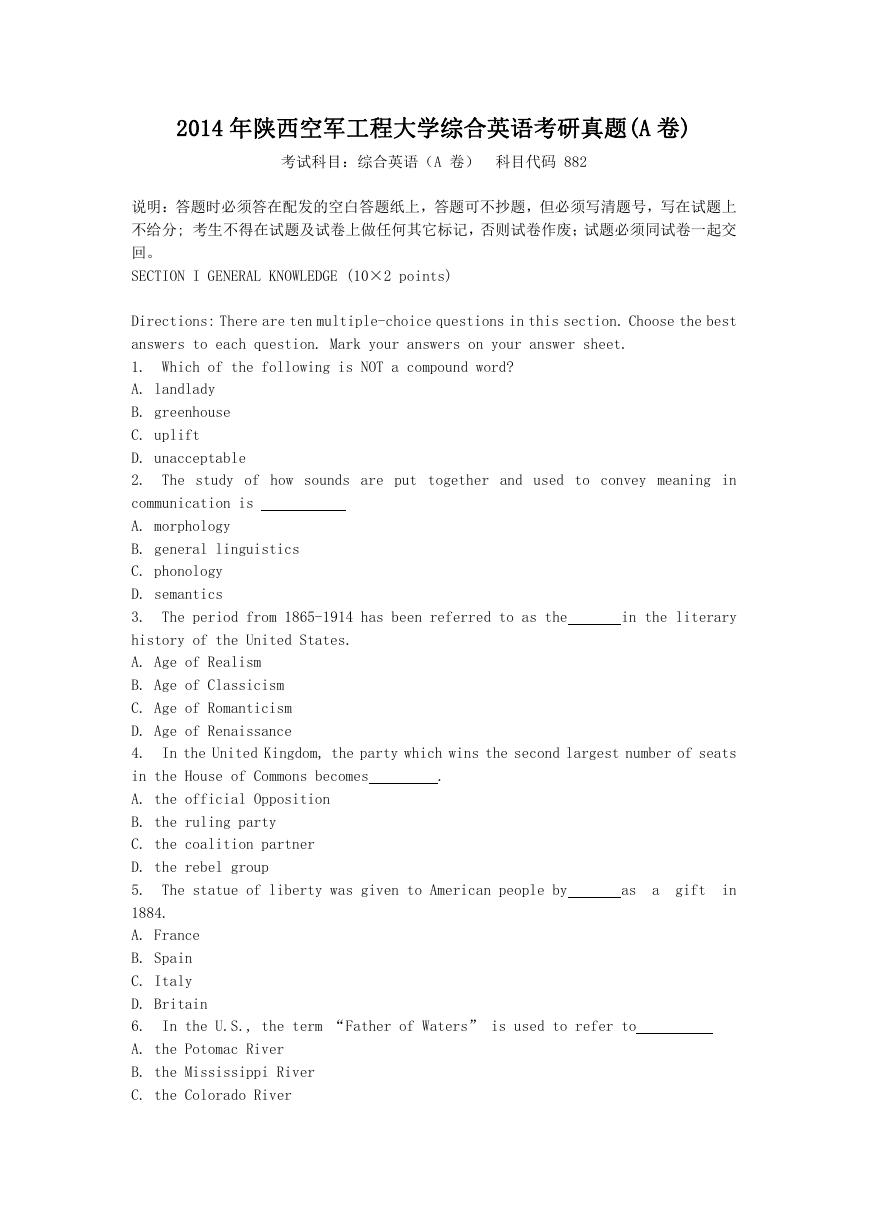
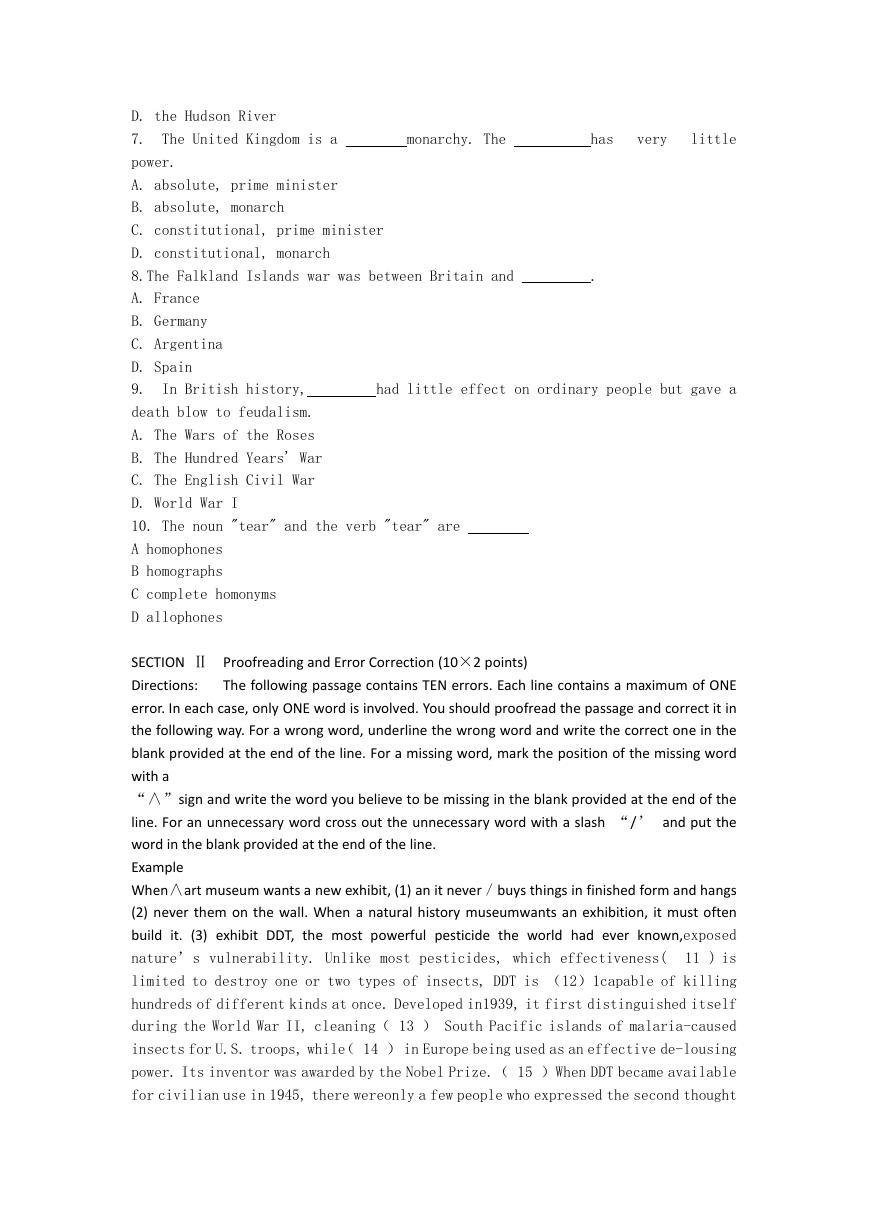
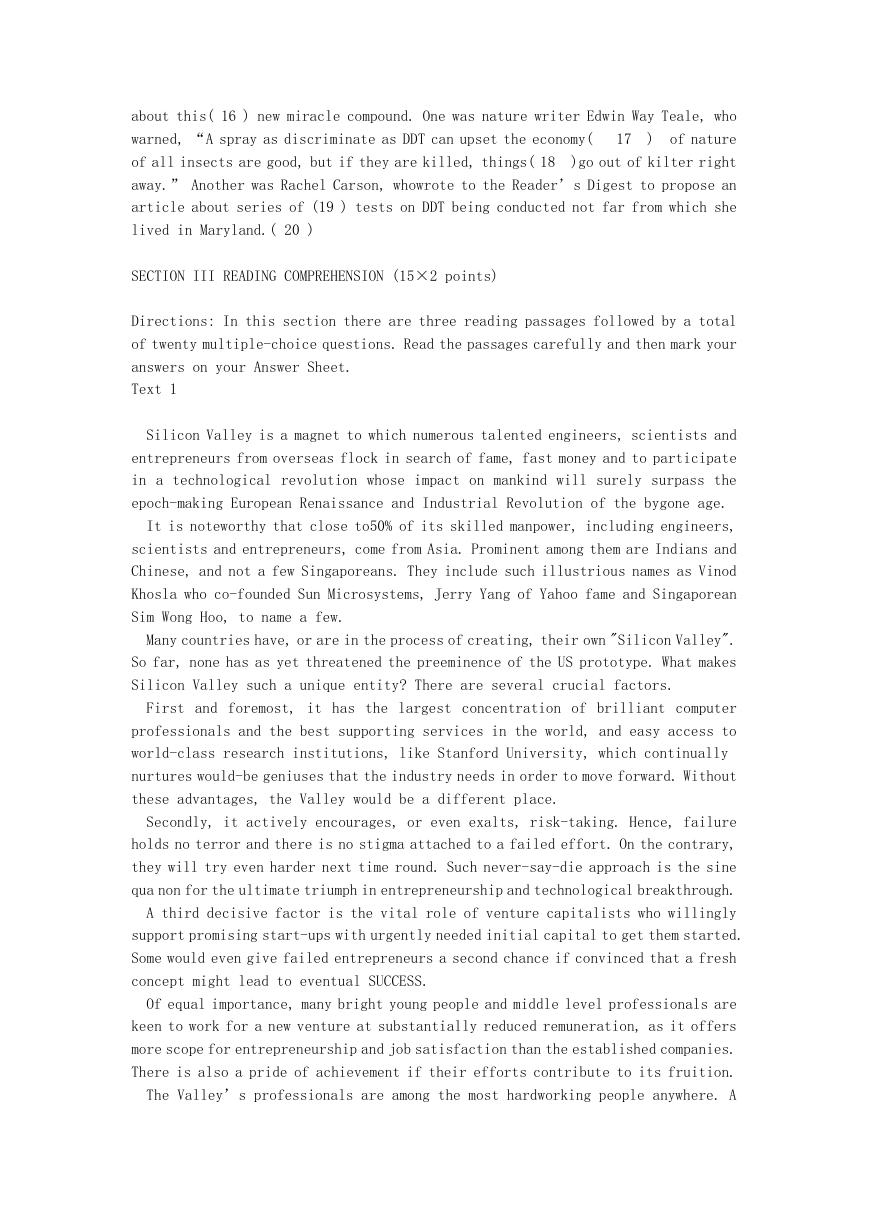
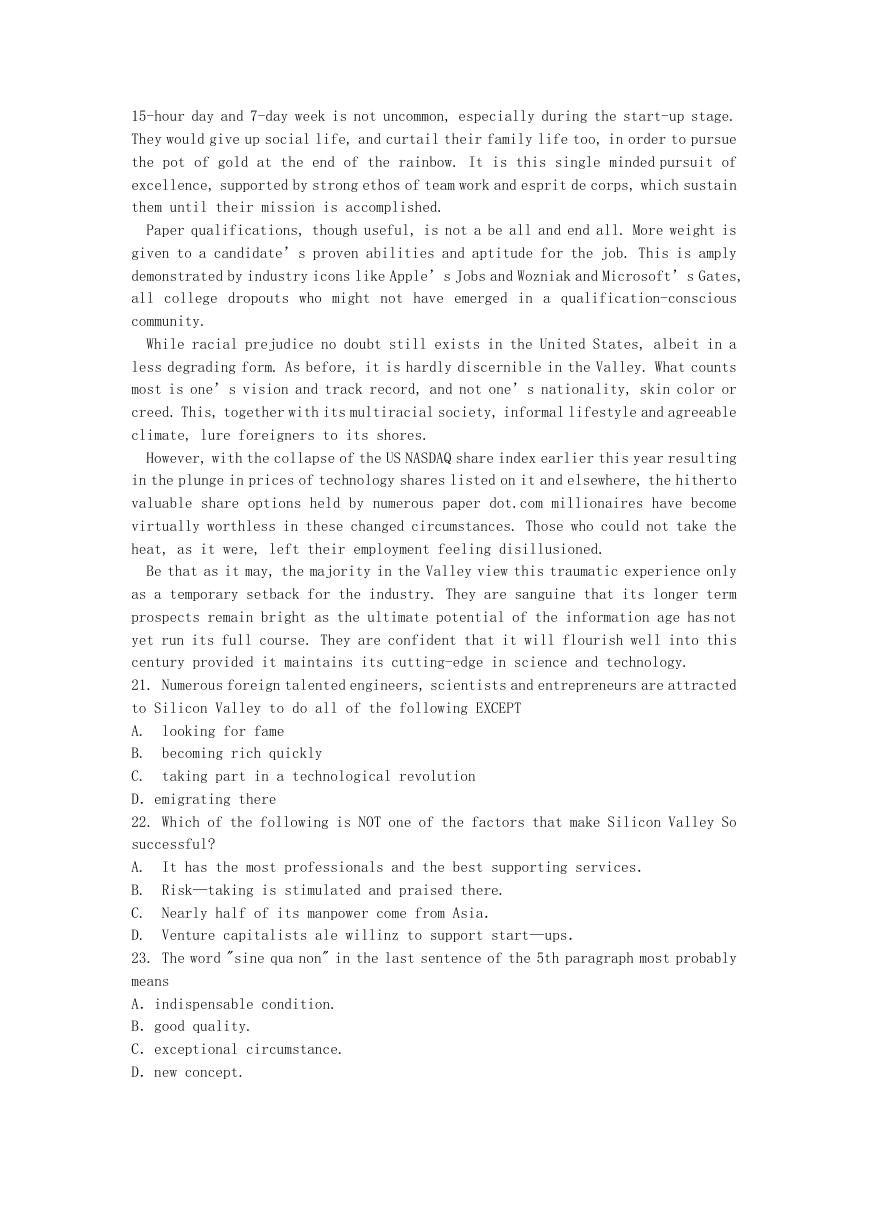
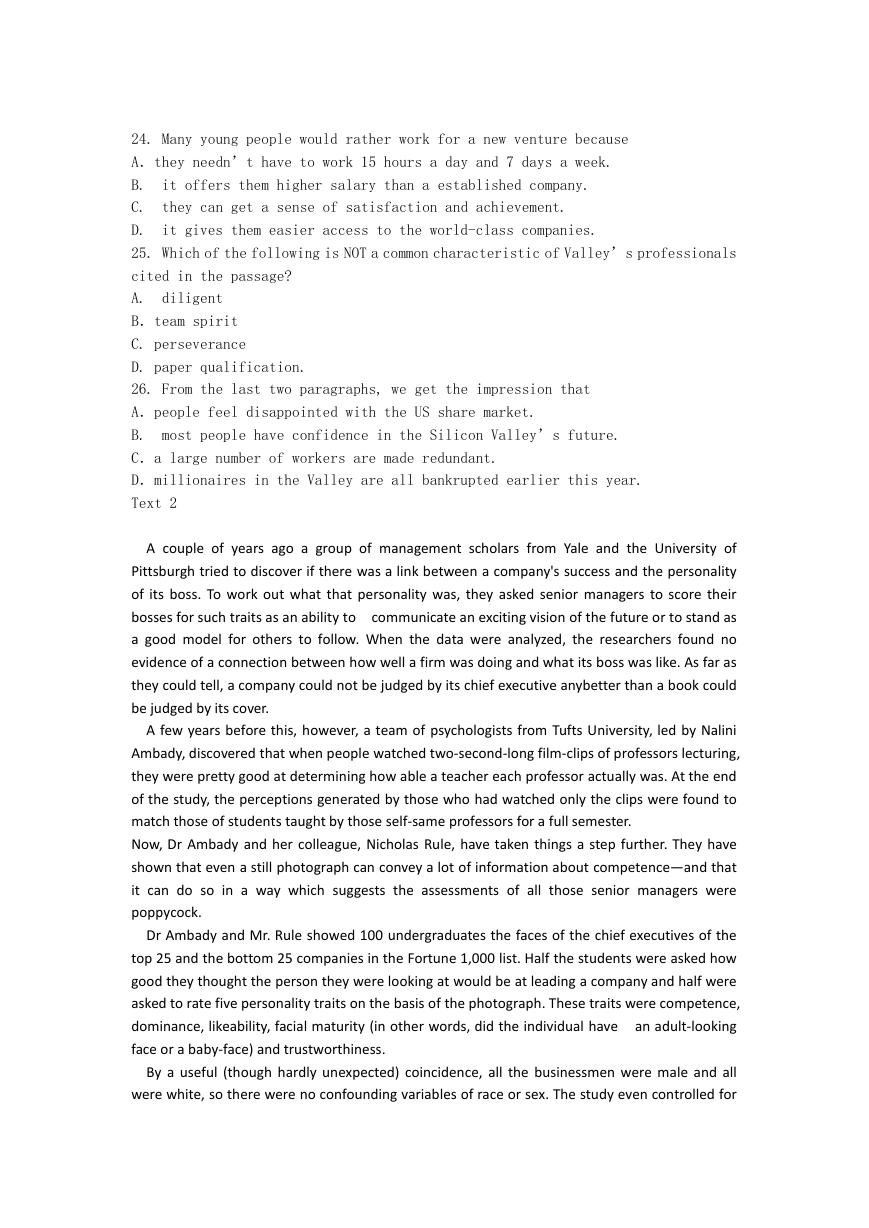
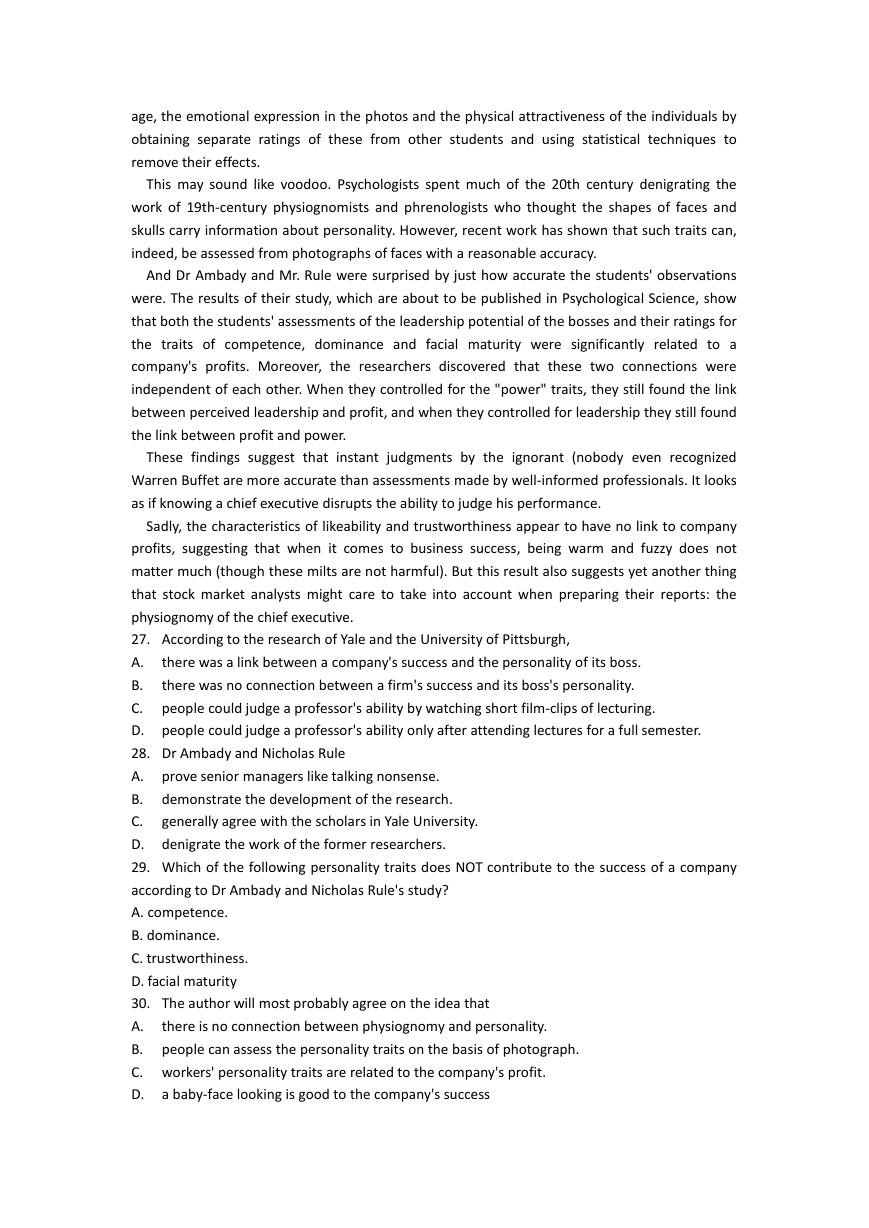
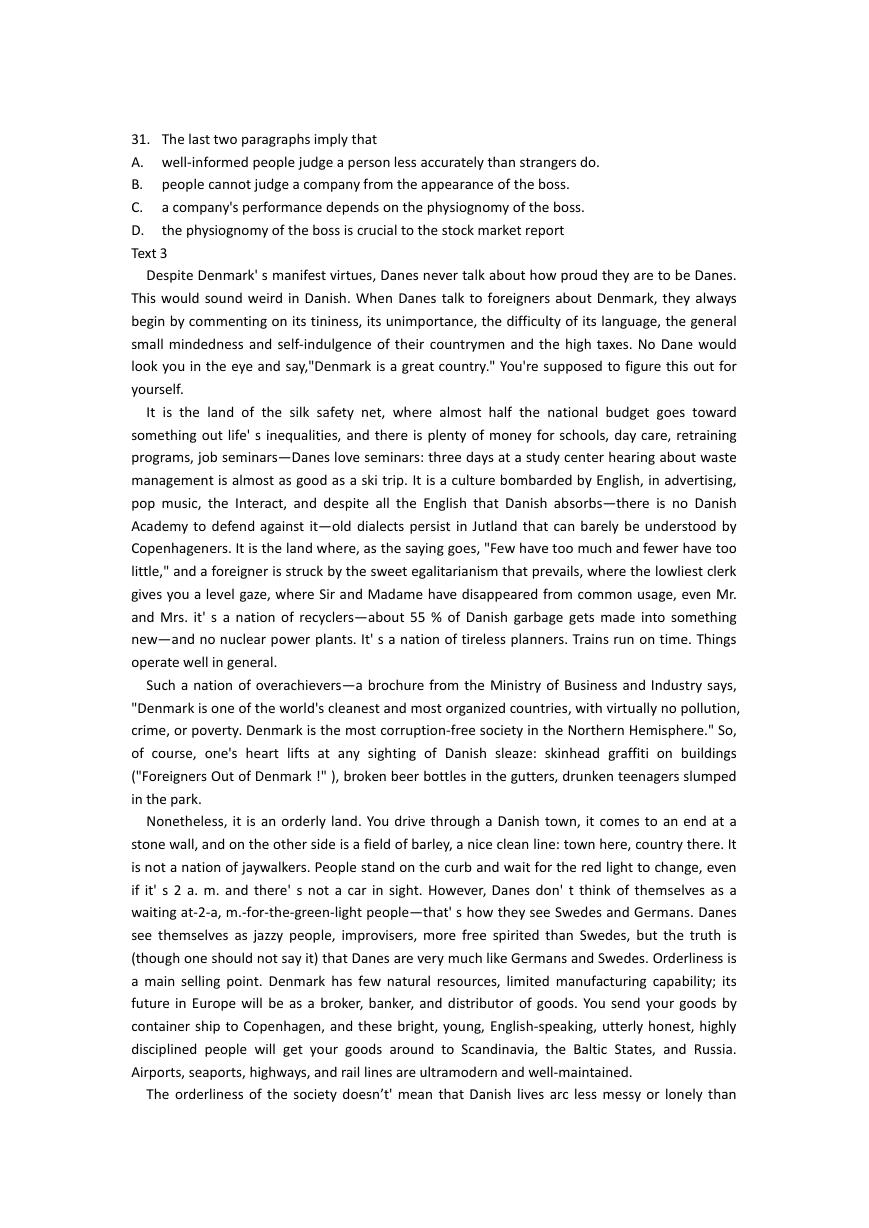
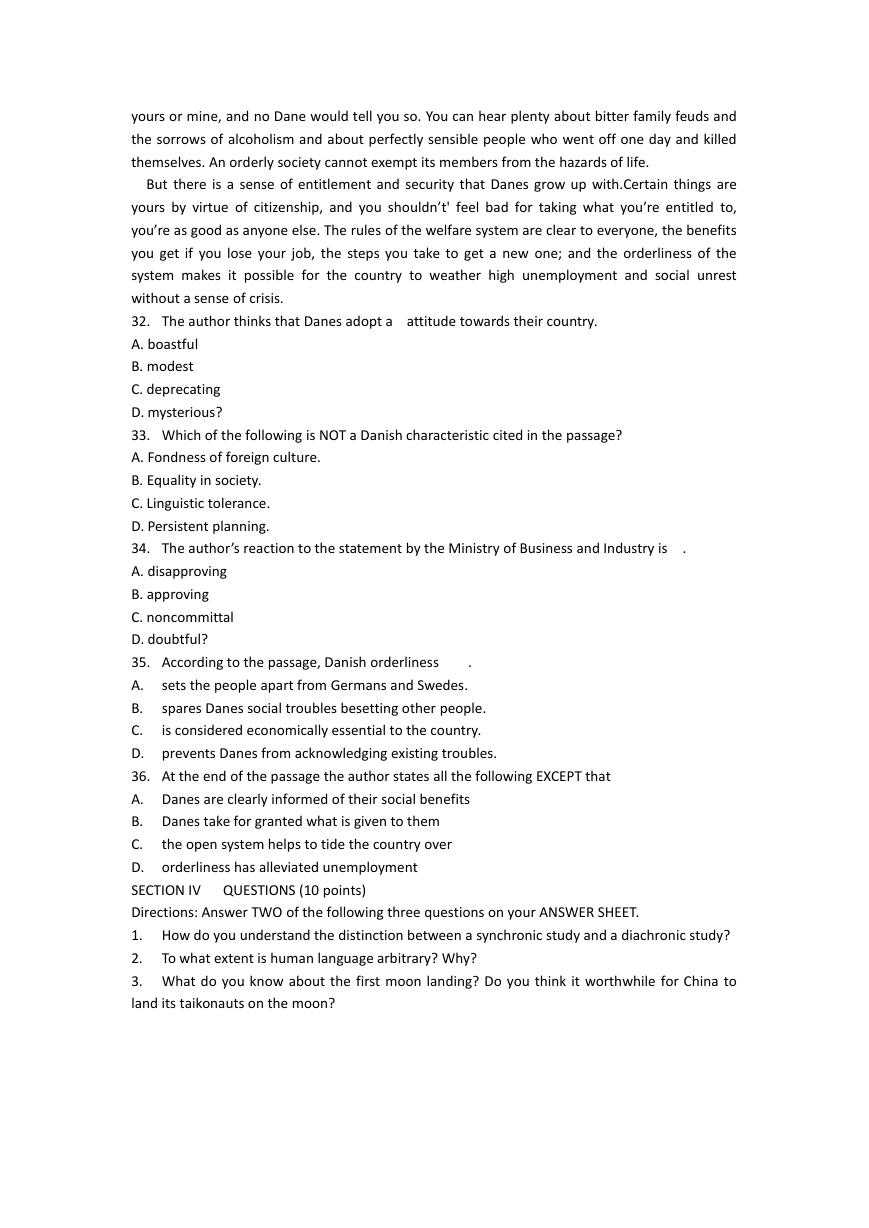








 2023年江西萍乡中考道德与法治真题及答案.doc
2023年江西萍乡中考道德与法治真题及答案.doc 2012年重庆南川中考生物真题及答案.doc
2012年重庆南川中考生物真题及答案.doc 2013年江西师范大学地理学综合及文艺理论基础考研真题.doc
2013年江西师范大学地理学综合及文艺理论基础考研真题.doc 2020年四川甘孜小升初语文真题及答案I卷.doc
2020年四川甘孜小升初语文真题及答案I卷.doc 2020年注册岩土工程师专业基础考试真题及答案.doc
2020年注册岩土工程师专业基础考试真题及答案.doc 2023-2024学年福建省厦门市九年级上学期数学月考试题及答案.doc
2023-2024学年福建省厦门市九年级上学期数学月考试题及答案.doc 2021-2022学年辽宁省沈阳市大东区九年级上学期语文期末试题及答案.doc
2021-2022学年辽宁省沈阳市大东区九年级上学期语文期末试题及答案.doc 2022-2023学年北京东城区初三第一学期物理期末试卷及答案.doc
2022-2023学年北京东城区初三第一学期物理期末试卷及答案.doc 2018上半年江西教师资格初中地理学科知识与教学能力真题及答案.doc
2018上半年江西教师资格初中地理学科知识与教学能力真题及答案.doc 2012年河北国家公务员申论考试真题及答案-省级.doc
2012年河北国家公务员申论考试真题及答案-省级.doc 2020-2021学年江苏省扬州市江都区邵樊片九年级上学期数学第一次质量检测试题及答案.doc
2020-2021学年江苏省扬州市江都区邵樊片九年级上学期数学第一次质量检测试题及答案.doc 2022下半年黑龙江教师资格证中学综合素质真题及答案.doc
2022下半年黑龙江教师资格证中学综合素质真题及答案.doc